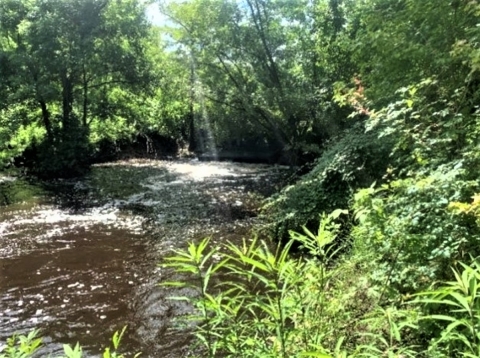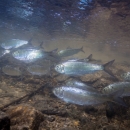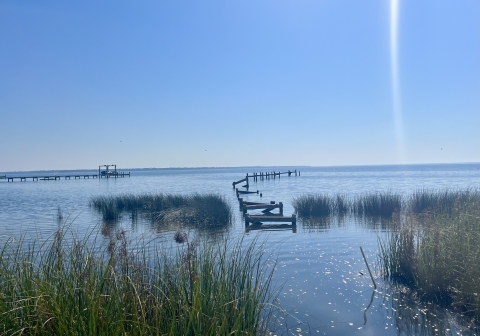What We Do
The Panama City Fish and Wildlife Conservation Office designs and implements monitoring and evaluation of fisheries resources and conveys the information to partners to coordinate our efforts and achieve shared conservation goals. The Panama City Fish and Wildlife Conservation Office provides science-based management of aquatic resources on a regional scale in the Gulf Coastal Plain of Alabama, Georgia, and Florida.
The team of biologists supports a dynamic aquatic restoration program that is based on addressing limiting factors for target species through the use of threat assessments. Information from these assessments is used to prioritize key life history bottlenecks, target critical locations, and identify restoration actions that best address issues impacting listed and at-risk species.
Management and Conservation
The Panama City Fish and Wildlife Conservation Office is a diverse team prepared to assist with sportfish, native fish, imperiled species, and invasive species invasive species
An invasive species is any plant or animal that has spread or been introduced into a new area where they are, or could, cause harm to the environment, economy, or human, animal, or plant health. Their unwelcome presence can destroy ecosystems and cost millions of dollars.
Learn more about invasive species assessment and management covering drainages in the Northeast Gulf of America, including portions of Alabama and Georgia. Whether it is diving for unionid mussels in the Chipola River or Yellow River, netting for native Gulf sturgeon in the Apalachicola River, restoring habitat and stream connectivity for imperiled species, or developing novel sampling gears and modeling tools to meet species recovery demands, we are here to serve.
Our team of biologists offer a wide array of knowledge and skills that support inter-jurisdictional fisheries management, threatened and endangered species assessments, and planning, design, and construction for habitat restoration projects.
Our Services
We offer a handful of services to support plant, fish, and wildlife conservation - especially federal threatened or endangered species. Different services are tailored to different groups and situations, so if you want to proactively support imperiled species conservation on your property or if you wonder how federally-protected plants and animals may factor into your situation, explore the services we offer.
Our Projects and Research
We use applied sciences and innovative technology to drive today's management practices and enable the U.S. Fish and Wildlife Service to work effectively with our partners to meet today's complex conservation challenges.
Gulf Sturgeon Recovery
The Panama City Fish and Wildlife Conservation Office is the recovery lead for the Gulf sturgeon (Acipenser oxyrhynchus desotoi) and has worked extensively on the injury assessment from the Deepwater Horizon oil spill to address Gulf sturgeon recovery needs. We assess and monitor the populations using the latest scientific advances to ensure the recovery of the species. Currently, we are leading multi-year projects from Natural Resource Damage Assessment (NRDA) funds to examine adult spawning habitats and juvenile foraging dynamics in designated critical habitat.
Okaloosa Darter Recovery
The Panama City Fish and Wildlife Conservation Office is the recovery lead for the Okaloosa darter (Etheostoma okaloosae). Due to the partnership between the Panama City Fish and Wildlife Conservation Office and Eglin Air Force Base, the Okaloosa darter has achieved recovery goals and population targets and was officially delisted from the Endangered Species List in July 2023.
Striped Bass Recovery
The Gulf striped bass (Morone saxatilis) is an inter-jurisdictional species native to rivers throughout the northern Gulf of America. A cooperative agreement was formed in 1987 between state and federal conservation agencies to "restore a self-sustaining stock of striped bass to the maximum extent possible" in the Apalachicola-Chattahoochee-Flint River system through various management and conservation strategies.
Freshwater Mussel Recovery
The Panama City Fish and Wildlife Conservation Office works together with the Florida Ecological Services Field Office in supporting recovery objectives for 16 federally listed freshwater mussels in Florida. Through the development of meso-habitat mapping, quantitative sampling methods, and stream restoration, the team addresses recovery objectives to maximize conservation delivery. In addition, the Panama City Fish and Wildlife Conservation Office hosts and coordinates mussels workshops to provide information (biology, genetics, habitat, systematics, and identification) to local, state, and federal agencies, consultants, and non-governmental organizations working with freshwater mussels.
Amphibian Habitat Restoration
The Panama City Fish and Wildlife Conservation Office works to restore and improve ephemeral wetland habitats to benefit species such as the Frosted flatwoods salamander (Ambystoma cingulatum), Reticulated flatwoods salamander (Ambystoma bishopi), and Gopher frog (Lithobates capito). Restoration work includes groundcover and hydrological restoration of these important habitats.
Stream Restoration
The Panama City Fish and Wildlife Conservation Office works with partners to restore identified watershed threats that are impacting listed species of freshwater mussels and fish through the use of natural channel design and stream geomorphology to stabilize stream banks, reduce sediment transport, and remove fish passage fish passage
Fish passage is the ability of fish or other aquatic species to move freely throughout their life to find food, reproduce, and complete their natural migration cycles. Millions of barriers to fish passage across the country are fragmenting habitat and leading to species declines. The U.S. Fish and Wildlife Service's National Fish Passage Program is working to reconnect watersheds to benefit both wildlife and people.
Learn more about fish passage barriers.
Dive Program
The Panama City Fish and Wildlife Conservation Office leads the region in providing dive support with the Regional Dive Officer Channing St. Aubin (Fisheries Biologist) stationed in Panama City, Florida. The regional dive program provides biologists with the technical skills and abilities to monitor and evaluate populations for listed and at-risk species in low visibility river conditions and assists in Lacey Act enforcement cases with the Office of Law Enforcement.
Laws and Regulations
Under several federal laws, Congress has directed the U.S. Fish and Wildlife Service to be stewards of our nation's plant, fish, and wildlife resources - particularly animals like birds and fishes that cross state and even international borders; federal threatened and endangered species; and the National Wildlife Refuge system - the system of federal lands dedicated to wildlife conservation. Congress has similarly directed the Fish and Wildlife Service to work with other federal agencies to minimize or eliminate negative impacts to plants, fishes, and wildlife from projects they fund or authorize. Learn more about the laws that direct our work.








